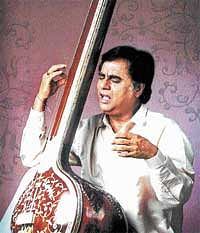Sound of music

Unlike films which remain rather run-of-the-mill and repetitive in its format, Indian film music has grown to be quite experimental. If you look back over many decades, you would find that film music has managed to branch out and take inspiration from all parts of world — there is the Jamaican beat of Harry Belafonte, or even the ektara of Bengali folk music. Music directors such as S D Burman, R D Burman and Shantanu Moitra have played around with various genres of music, which has led to a wide collection of tunes that can be attributed to the broader category of Indian film music. No wonder then that ghazals too have found a way in and carved a niche for themselves in our current music scenario.
Think Jagjit Singh, and one would immediately be reminded of the huge inlfuence his ghazals had on our films. How can one forget the singer mesmerising us, listeners, with classics such as Hothon se choo lo tum mera geet amar kar do (Prem Geet) and the more contemporary, Hosh walon ko khabar (Sarfarosh). The magical quality of these songs lies in the fact that irrespective of one’s mood, they always manage to refresh and re-energise. Lovely lyrics by Indeevar and Nida Fazli, exemplary singing by Jagjit Singh, and soulful music byJatin Lalit made these songs timeless classics.
However, the ghazal was, is, and will continue to remain a lyricist’s song. While the tune and the manner in which it is sung is also important, a ghazal’s true worth lies in its lyrics. No wonder Mirza Ghalib and his soulful ghazals with unparalleled poetry were the founding stones of what would soon become a craze in the Hindi film music industry. A film on the legendary poet had a number of his ghazals which went on to become superhit songs. Gulzar’s television serial on Mirza Ghalib’s life showcases these popular ghazals and the strength and popularity of these songs. Fifty years down the line, these songs are still heard by people. Songs like Dil-e-nadaan and Nuktachin hai have the capability of being chartbusters even today.
Not to be left behind, some legendary film music lyricists like Majrooh Sultanpuri, Anand Bakshi and Javed Akhtar have also played a big role in promoting ghazals in Hindi films. True to the spirit of Indian film music, lyricists and music directors experimented with ghazals as well.
While lyricists have simplified the verses and converted them into a simpler form for the
masses, composers don’t seem to have thought twice before straying away from traditional ghazal tunes, and making songs that were easier to sing, hum, and remember.
Take two Gulzaar-R D Burman numbers, for example — Ek hi khwaab kaeen baar dekha hai maine (Parichay) or Huzoor is kadar bhi (Masoom). At first, neither of these will appear to qualify as a true ghazal, tune or lyric-wise. However, on repeated hearing, one would find that these songs tend to grow on the listener, just as a ghazal does. They are just as soft and soothing to the ear. And, of course, both talk about love. The most remarkable feature of these songs, other than the way in which they were sung, are the lyrics penned by Gulzaar.
Over time, the language and lyrics that were often used in ghazals have been watered down to a simpler format. For instance, Pankaj Udhas’Chitti aayee hai (Naam), which became a rage across the nation, stood out for the meaningful lyrics carefully chosen by Anand Bakshi.
Similarly, Sameer’s penning of his thoughts in Jeeyen to jeeye kaise bin aapke from the Salman Khan-Madhuri Dixit-Sunjay Dutt superhit, Sajaan, appealed to the masses for the very same reason. These songs were more straightforward in conveying their message of love, or perhaps, the pain that comes with a lost love. The traditional format of a ghazal was followed in every way, except for the words that comprised it.
Interestingly, this simplification has not been restricted to ghazals alone. Thumris and other such forms of Hindustani classical music have gone through a similar process. Evidence of the same can be seen in Amar Prem’s Kuchh to log kahenge or even Lawaris’s Mere angane mein. However, these songs never reflected their true thumri or dadra self, due to the magical touch of R D Burman and Kalyanji Anandji, who modified these songs into numbers which had a tremendous mass appeal!
So, do we earn the wrath of puritans by saying that ghazals have actually benefited from Hindi films? Probably yes, but it is worth the risk. After all, what else is music there for? Entertainment, yes. Happiness, yes. Of course, it has also opened the window for some self-introspection. Ghazals have managed all these, and perhaps, even more.
Deccan Herald is on WhatsApp Channels| Join now for Breaking News & Editor's Picks